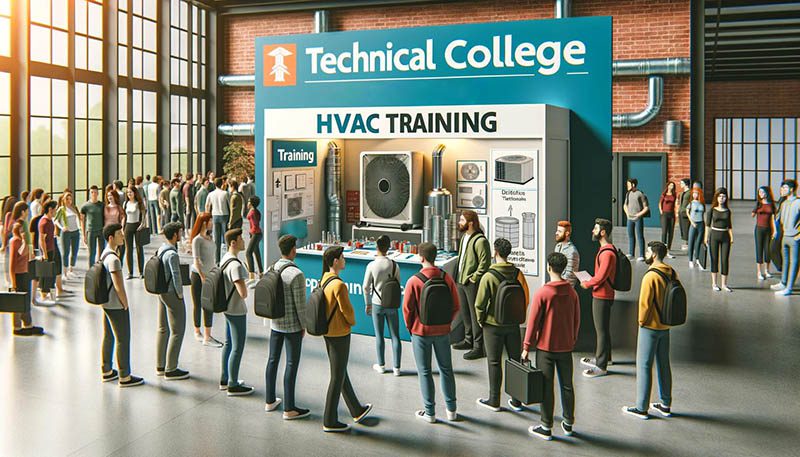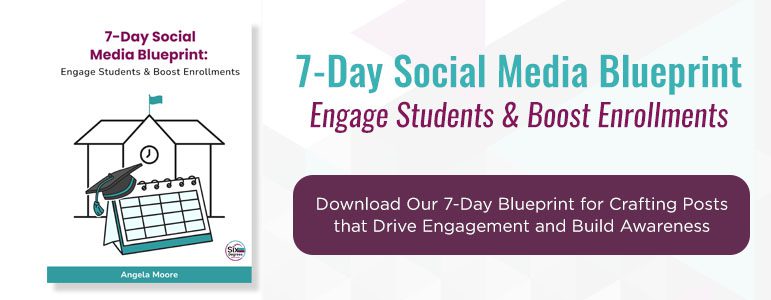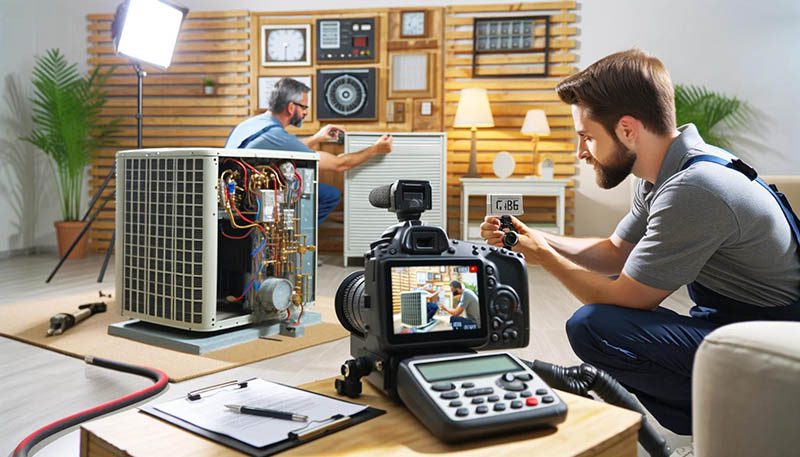In today’s competitive landscape, HVAC training programs find themselves at a pivotal point. The challenge isn’t just to attract students; it’s to stand out as the definitive choice for those deciding on their career paths in a market flooded with options. It’s about more than offering a program; it’s about positioning your institution as the go-to destination for future HVAC professionals looking to make a real impact in the fields of heating, ventilation, and air conditioning.
The strategy involves tapping into the ambitions of prospective students and showcasing how your program aligns with their dreams of innovation, sustainability, and making a difference. This introduction paves the way for a detailed discussion on effective strategies and creative approaches to boost your school’s profile and attractiveness, ensuring your HVAC training program is the preferred option for the industry’s future stars.
Let’s begin our exploration of how your institution can not only hold its ground but excel by drawing in the brightest minds, poised to redefine the HVAC landscape.
Table of Contents
- The Importance of Understanding Your Audience
- Strategies to Increase Enrollment
- Apprenticeship Programs
- Leveraging Webinars
- Educational Videos
- Conclusion
Let’s dive into the strategies that can transform your HVAC training program. We’re not just talking tactics. We’re crafting a future. So, keep reading. By the end, you’ll not only see the potential. You’ll be ready to unleash it. And remember, if you’re looking to supercharge your program’s enrollment, a free strategy session is just a click away. Let’s make those enrollment numbers soar!
Understanding Your Audience and the Competitive Landscape
Before diving into the key strategies to increase enrollment in your HVAC training program, it’s crucial to lay the groundwork. Understanding who your prospective students are and what sets your program apart in a crowded market can significantly enhance the effectiveness of the strategies outlined in the next section.
Identify Your Prospective Students
Who are you trying to reach? Are they recent high school graduates, career changers, or professionals seeking advancement? Understanding their needs, goals, and the challenges they face in accessing education is the first step in crafting messages that resonate. This knowledge informs how you share success stories, what financial assistance you highlight, and how you tailor your digital marketing efforts.
Assess the Competitive Landscape
What are other HVAC training programs offering, and how can you differentiate yours? Analyzing your competitors helps identify gaps in their offerings that your program can fill. Whether it’s specialized courses in sustainable technologies, partnerships with leading HVAC companies, or unique hands-on training opportunities, knowing what makes your program unique is key to standing out.
Leverage Your Unique Selling Propositions (USPs)
Once you’ve identified your USPs, make them the cornerstone of your marketing and outreach efforts. Whether it’s through your website, social media, or direct engagement with potential students, consistently highlighting what makes your program unique will attract the right students.
Engage with Your Audience
Understanding your audience and the competitive landscape is not a one-time task but an ongoing effort. Engage with prospective and current students, alumni, and industry partners to continually refine your understanding and adjust your strategies accordingly. This engagement will not only provide valuable insights but also strengthen your program’s community.
Transitioning into the detailed strategies for increasing enrollment, it’s clear that a deep understanding of your target audience and competitive landscape is foundational. With this insight, you’re better equipped to implement the strategies that follow, from promoting alumni success stories to leveraging digital marketing and beyond.
Key Strategies to Increase Enrollment
Promote Success Stories of HVAC Alumni
Sharing the success stories of HVAC alumni can be incredibly powerful. These narratives not only inspire but also provide tangible evidence of what future students can achieve. By highlighting the journeys of past students who have navigated the path from training to career success, programs can illuminate the real-world impact of their education. Success stories serve as a beacon, guiding prospective students towards envisioning their potential futures. Featuring these stories across various platforms – from social media to newsletters – can significantly amplify the message that with the right training, success is within reach.
Offer Financial Assistance and Scholarships
Financial barriers should never deter aspiring HVAC professionals. That’s why discussing financial assistance and scholarship opportunities is crucial. By making these options prominent, training programs can demonstrate their commitment to accessibility and inclusivity. Detailing the process to apply for financial aid, highlighting success stories of scholarship recipients, and explaining how these financial supports can transform the educational experience are key steps. This strategy not only opens doors for more students but also strengthens the message that the HVAC industry is an accessible and viable career path for many.
Collaborate with Industry Partners
Partnerships with industry leaders are vital. They provide students with hands-on experience, making their learning journey as practical as it is theoretical. These collaborations can range from internships to on-the-job training, offering a glimpse into the daily realities of HVAC professionals. Highlighting these partnerships in promotional materials showcases the program’s connection to the industry and its commitment to preparing students for the workforce. It’s a testament to the program’s quality and its alignment with industry standards and needs.
Utilize Digital Marketing Strategies
In the digital age, an online presence is non-negotiable. Effective digital marketing strategies can significantly broaden a program’s reach. SEO optimization ensures that programs appear at the top of search results, while targeted social media campaigns can engage potential students on platforms they frequently use. Email marketing, content marketing, and online webinars are additional tools that can draw attention. These strategies not only increase visibility but also allow programs to communicate their unique value propositions directly to interested parties.
Host Information Sessions and Open Houses
Information sessions and open houses are invaluable for making personal connections with prospective students. These events offer a platform for direct engagement, allowing individuals to ask questions, tour facilities, and meet faculty and current students. It’s an opportunity to experience the program’s culture firsthand and see the facilities where they will learn their trade. Effectively promoted through digital channels and community outreach, these events can significantly impact enrollment numbers by converting interest into action.
By meticulously addressing each of these strategies with detailed planning and execution, HVAC training programs can significantly increase their enrollment. Each strategy plays a crucial role in building a comprehensive approach to attract, engage, and enroll the next generation of HVAC professionals.
Highlighting Apprenticeship Opportunities in Your HVAC Program
For HVAC training programs aiming to set themselves apart and attract more students, showcasing or integrating apprenticeship opportunities can be a game-changer. Apprenticeships offer a unique blend of classroom learning and real-world experience, acting as a bridge between theoretical knowledge and practical application. By partnering with local businesses and industry professionals to offer apprenticeships, your program not only enhances its curriculum but also demonstrates a commitment to student success beyond the classroom.
Enhancing Program Appeal with Apprenticeships
Incorporating apprenticeships into your HVAC program can significantly increase its appeal. These opportunities allow students to gain hands-on experience, making them more attractive to employers upon graduation. For schools, advertising these partnerships and success stories can be a powerful marketing tool. It showcases your program’s direct link to employment opportunities and its role in preparing industry-ready professionals.
Competing with Apprenticeship Offerings
If your program does not currently offer apprenticeships, now is the time to consider establishing such partnerships. The presence of apprenticeship opportunities can be a deciding factor for prospective students when choosing between programs. By highlighting how your school facilitates these real-world experiences, you’re not only showcasing your commitment to comprehensive education but also providing a tangible path to employment, which can greatly enhance your program’s competitiveness.
A Win-Win for Students and the Industry
Apprenticeships are more than just training; they are a pathway to job security in the HVAC field. For students, the earn-while-you-learn model offers financial benefits and career advancement opportunities. For the industry, it ensures a steady influx of skilled workers ready to tackle the challenges of modern HVAC systems. Training programs that highlight or offer apprenticeships demonstrate their role in filling the skills gap, benefiting both students and the broader industry.
Leveraging Apprenticeships in Recruitment and Marketing
To leverage apprenticeships effectively, HVAC training programs should highlight these opportunities in all marketing and recruitment efforts. Testimonials from past apprentices, success rates of job placement post-completion, and detailed information on how apprenticeships are integrated into the curriculum can be compelling content for prospective students. Showcasing these elements not only illustrates the practical benefits of your program but also positions it as a leader in providing career-ready education in the HVAC industry.
By focusing on the value apprenticeships add to HVAC training programs and how they can be used to attract and retain students, schools can more effectively communicate their commitment to providing education that leads to real-world success. This approach not only benefits the students but also serves the industry’s need for skilled professionals.
Leveraging Webinars and Workshops to Enhance HVAC Training Programs
In the competitive landscape of HVAC training, offering webinars and workshops can significantly enhance your program’s appeal and effectiveness. These educational tools not only provide prospective and current students with valuable insights into the HVAC industry but also position your program as a leader in hands-on and accessible learning.
Webinars: Expanding Educational Reach
Webinars serve as a powerful platform to showcase the depth and breadth of your HVAC program. They offer a convenient way for prospective students to explore what your school offers, including insights into career paths, emerging technologies in the HVAC industry, and the long-term value of obtaining comprehensive training. By hosting regular webinars that cover a range of topics, from technical skills to industry trends, your program can attract a wider audience and provide valuable guidance to those considering a career in HVAC.
Workshops: Providing Real-World Experience
Hands-on workshops are critical in demonstrating the practical side of HVAC training. They allow participants to experience the day-to-day realities of HVAC work, from troubleshooting systems to installing new technologies. By offering workshops, your school can give prospective students a glimpse into the engaging, hands-on learning environment you provide, which is crucial for preparing skilled professionals. These sessions can effectively illustrate how your program bridges the gap between theoretical knowledge and practical application, a key selling point for potential students.
The Strategic Role of Webinars and Workshops
Integrating webinars and workshops into your marketing and recruitment strategy can play a significant role in increasing enrollment. They act as interactive brochures, showcasing the strengths and unique aspects of your HVAC program. Furthermore, these sessions can help build a community around your school, engaging potential students, industry partners, and alumni in meaningful discussions about the future of HVAC and the critical role of skilled training in this sector.
Implementation in Your Program
To implement webinars and workshops effectively, consider the following steps:
- Identify Key Topics: Focus on subjects that highlight the uniqueness of your program and address common questions or interests among prospective students.
- Engage Industry Experts: Collaborate with HVAC professionals and alumni to provide real-world insights and success stories.
- Promote Widely: Use your school’s website, social media channels, and email newsletters to promote these events, reaching out to both prospective students and the wider HVAC community.
- Gather Feedback: After each session, collect feedback to continuously improve and tailor your offerings to meet the needs and interests of your audience.
By thoughtfully integrating webinars and workshops into your HVAC training program’s offerings, you can enhance your school’s visibility, attract more students, and ultimately contribute to the development of well-prepared professionals ready to meet the challenges of the HVAC industry.
Enhancing HVAC Training Programs with Educational Video Series
In today’s digital era, incorporating an educational video series into your HVAC training curriculum can significantly enrich the learning experience. Think of it as creating a specialized learning channel for your students, offering them 24/7 access to a wealth of knowledge that complements traditional classroom and hands-on training.
Bringing HVAC Concepts to Life
Utilize video series to break down complex HVAC concepts into digestible, engaging content. These visual aids act as virtual mentors, offering students the ability to learn at their own pace with the flexibility to pause, rewind, and revisit challenging topics. This approach ensures a more inclusive learning environment where all students can thrive.
Practical Maintenance Tips at Students’ Fingertips
Extend the learning beyond foundational knowledge by incorporating maintenance and repair tutorials into your video series. Detailed visual guides simulate real-life scenarios, providing students with a practical understanding of HVAC systems. This method bridges the gap between theoretical knowledge and practical application, empowering students to confidently apply what they’ve learned in real-world settings.
Keeping Pace with Industry Trends
The HVAC industry is constantly evolving, with new technologies and methodologies emerging regularly. An up-to-date video series can serve as a dynamic resource for students to stay informed about the latest industry trends, tools, and technologies. This foresight prepares them not only for the current landscape but also for future advancements, ensuring they are well-equipped to enter the workforce as knowledgeable, skilled professionals.
Implementing Educational Video Series in Your Program
To effectively incorporate an educational video series into your HVAC training program, consider the following strategies:
- Identify Key Learning Objectives: Tailor your video content to align with both foundational HVAC concepts and advanced techniques, ensuring a comprehensive learning experience.
- Engage with Experts: Collaborate with industry professionals and educators to produce content that is both informative and engaging, enhancing the credibility and appeal of your program.
- Promote Active Learning: Encourage students to engage with the video content actively by integrating quizzes, interactive discussions, and practical assignments that complement the videos.
- Continuous Update and Improvement: Regularly review and update your video series to reflect the latest industry standards, technologies, and best practices, keeping your program at the forefront of HVAC education.
By leveraging an educational video series, HVAC training programs can offer a more dynamic, flexible, and comprehensive educational experience. This not only enhances the appeal of your program but also prepares students more effectively for successful careers in the HVAC industry. Explore the potential of video learning in your curriculum and take a significant step toward revolutionizing HVAC education.
Next Steps for Your HVAC Training Programs
We’ve journeyed through a landscape of strategies designed to invigorate HVAC training programs. From the personal triumphs shared in alumni success stories to the hands-on learning experience of apprenticeships, each strategy plays a vital role in molding the future of HVAC technicians.
Financial assistance and scholarships open doors for aspiring students, making education accessible to all. Collaborations with industry partners bridge the gap between theoretical knowledge and practical application, ensuring students are job-ready. Digital marketing strategies and informative events like webinars and workshops widen our reach, attracting a diverse pool of prospective students. And let’s not forget the power of educational video series, which brings complex concepts to life, making learning both engaging and effective.
Are you ready to take the next step in shaping the future of HVAC education? Let’s discuss how we can transform these strategies into action. Schedule your free strategy session today, and together, we’ll turn aspirations into achievements. Let’s ensure a bright, sustainable future for the HVAC industry, one student at a time.














